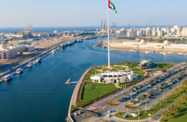Year-end forecasts of increased revenue and fiscal deficit relief have brightened Sharjah’s near- to medium-term outlook, with the emirate’s authorities working to promote non-hydrocarbons sectors as attractive investment propositions on the back of slower growth in 2015.

Macroeconomic performance
Ratings agency Moody’s assigned Sharjah a stable outlook in its November 30 update, noting that emirate’s debt burden and debt affordability were favourable when compared with its peers.
“At the end of 2015, Sharjah’s central government debt stood at 13.3% of GDP, this was lower than the UAE consolidated government’s standing of 19%, as well as the median level for A-rated peers,” Mathias Angonin, lead analyst at Moody’s Sovereign Risk Group, told OBG.
However, worse-than-expected economic growth in 2015 resulted in Standard & Poor’s (S&P) downgrading the emirate’s outlook to negative and lowering its forecasted 2016-19 real GDP growth rate from 3% to 2% earlier in August.
“Alongside a substantial revision to population data, the main reason for S&P changing their outlook to negative concerned the government’s fiscal policy in 2015 – whereby it increased capital expenditures while delaying a number of expected revenue-raising measures such as land sales. This allowed the fiscal deficit to reach 4.2% of GDP and government debt to jump from 5% to 10%,” Benjamin Young, associate director of Sovereign and International Public Finance Ratings at S&P, told OBG.
This pattern is expected to be largely reversed in 2016, with S&P forecasting that revenues will increase by 39% on 2015 while expenditure will remain flat, providing significant relief to the fiscal deficit. Furthermore, the addition of new revenue streams, such as the expected introduction of value-added tax in 2018-19, has been highlighted by both S&P and Moody’s as having the potential to improve the emirate’s outlook and underpin the government’s fiscal position.
Another factor in the S&P downgrade was the release of the 2016 census, which put the emirate’s population at 1.41m – a 64% increase on the previous year’s estimate of 0.86m. While both S&P and Moody’s welcomed the increased government transparency represented by a fully accountable census, the new figures meant that GDP per capita – S&P’s measure of economic wealth – sank by more than $10,000 in 2016.
The emirate also completed a two-year process of debt restructuring this year, which saw Sharjah issue a five-year, $500m sukuk (Islamic bond) in January that has resulted in lower interest payments. The bond was met with high demand, attracting orders of more than $950m – an outcome seen as a reflection of accurate pricing and a solid start to the year in a cautious investor environment.
New impetus to international investor appeal
Although the emirate has suffered some knock-on effects from weakening investor sentiment in the broader GCC region, its non-reliance on hydrocarbons means that there is plenty of potential to stimulate economic growth by attracting investment from outside the GCC.
Speaking to local media this year, Marwan al Sarkal, CEO of the Sharjah Investment and Development Authority (Shurooq), revealed that oil contributes only 1% of Sharjah’s GDP, while real estate and business services contribute 22%, followed by manufacturing (17%), and wholesale and retail (12%).
While the emirate has not traditionally marketed itself as an international investment destination, the last few years have seen significant changes to this position, as demonstrated by the activities of Shurooq. September saw the emirate host the Sharjah FDI Forum for the second year, with Shurooq unveiling its “Invest in Sharjah” initiative, which aims to promote the emirate and streamline the process of investing in it.
Rents dip but interest in real estate remains strong
As in Dubai and elsewhere across the UAE, rents on housing fell in Sharjah, where a 7.1% drop in prices was recorded in the first 11 months of the year. Despite this decrease, rent prices remain 30% higher than they were at the beginning of 2012.
“This is a very good market for families, and we are continuing to see a lot of interest in Tilal City from buyers in the region and further afield. Most of the people buying plots plan to live there, which is a good thing,” Suzanne Eveleigh, director of Cluttons Sharjah, told OBG. Tilal City, which will house 65,000 inhabitants, is expected to open in 2019.
Oxford Business Group is now on Instagram. Follow us here for news and stunning imagery from the more than 30 markets we cover.


